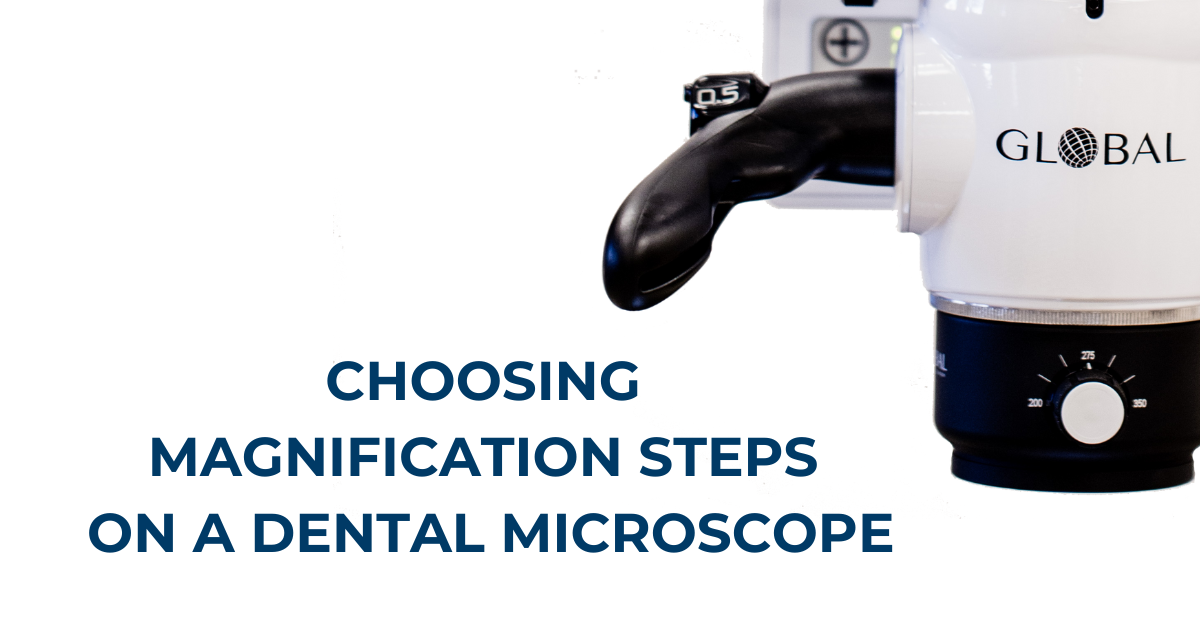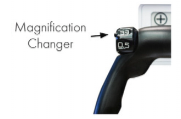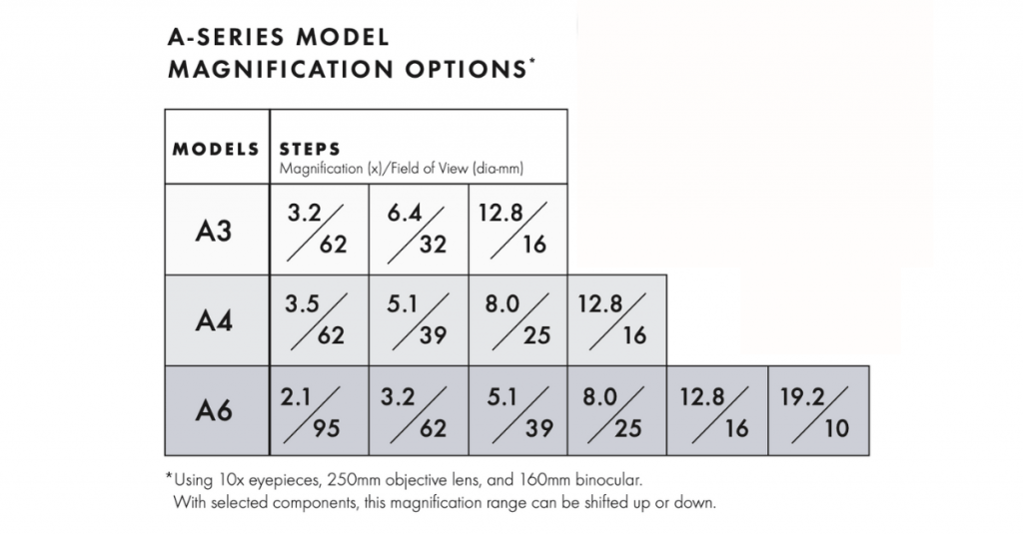How to Choose Magnification Steps on a Dental Microscope

If you’ve ever had the opportunity to demo a dental microscope, you may already be familiar with the concept of magnification steps. If that term is new to you, it’s the number of different magnification levels a microscope user can select from during a procedure. In today’s marketplace, one of the ways microscope brands/models differentiate and price their equipment is based on the magnification level and number of steps provided. As with most technologies, there is a wide variety of magnification levels and steps available on dental microscopes, so it can be difficult to determine what exactly you need. Fortunately, we are here to explain it all so you can make an informed decision!
The magnification level required for dental procedures correlates to the amount of detail needed to perform diagnosis and/or treatment. Lower magnification levels are used to help doctors gain a general overview of the anatomy, similar to the powers you’ll find on dental loupes. Higher levels help view more detail, typically for deeper inspection of cracks, caries, or root canals.
The magnification steps manually increase or decrease the magnification power, most commonly ranging between 3-6 steps. Together, the magnification levels and steps impact how you’ll use your equipment, and what you’ll be able to visualize.
The more you understand about magnification levels and steps, the more effective you’ll be when comparing brands and models to choose the right scope for your practice. Many manufacturers use these metrics to compare to other brands, which will impact the price you’ll pay and your eventual return on investment.
Since we’ve been in the dental microscope business for over 25 years, we have extensive experience of helping doctors understand their options and matching them to the right equipment. When it comes to magnification steps, we know you get the most value when your microscope provides a magnification level(s) that allows you to clearly visualize the anatomy you need to see, while not including magnification levels that you may never use. Today, we’ll help you understand the magnification capabilities of different dental microscopes to help you compare.
Magnification Steps: A Brief Overview
 The optical principle of magnification steps comes from an astronomical telescope. A magnification changer is composed of a turret with two telescope systems of different magnification levels. By manually turning the turret, the telescope systems can be viewed in either direction to achieve different magnification levels.
The optical principle of magnification steps comes from an astronomical telescope. A magnification changer is composed of a turret with two telescope systems of different magnification levels. By manually turning the turret, the telescope systems can be viewed in either direction to achieve different magnification levels.
The advantage of step magnification changers is their compact construction with low technical complexity, yet high optical quality and efficiency. Some manufacturers offer zoom systems, which eliminate the need for manually dialing steps. However, this premium feature comes with a premium price tag – and most doctors we speak with haven’t been able to justify additional value from step-less zoom.
Comparing Microscopes to Loupes
Before dental microscopes, many dentists were introduced to magnification through loupes. Still, dental loupes have been somewhat limited in the magnification levels they can provide, generally ranging in 2X-6X magnification for general dental procedures. 2X is twice the power of the naked eye, while 6X is six times. Already, the visual difference you get at 2X is dramatically different from what you see at 6X, hence the concept of using different magnification levels.
While older loupe technologies only allowed for one power of magnification, newer styles provide the ability to shift between magnification levels on the fly. This concept of magnification steps was revolutionary to providing doctors the best visualization, allowing them to use several levels of magnification to zoom from overview to the detail.
Dental microscopes further enhance your visualization by increasing the top-range of higher power magnification to up to 20X and pairing it with bright, shadow free light. This range helps doctors see beyond an overview of a complete arch or quadrant, to visualize even smaller details like cracks, caries, or root canals. Seeing in this level of finer detail is clinically proven to improve efficiencies and outcomes in many endodontic and restorative procedures.
Factoring Field of View
An additional metric most dental microscope manufacturers will use to compare the range of their magnification levels is field of view. Loupes typically have a smaller field of view, especially as magnification level increases. The field of view a microscope provides includes a much wider area as compared at the same levels of magnification. A microscope provides a clear view of the full dentition at lower magnification powers, while still being able to see surrounding tissues at higher magnification.
Field of view is also a consideration when comparing dental microscopes. Most microscope manufacturers will publish the field of view range available at each magnification level, typically measured in dia-mm.
For example, below are the published magnification steps on our Global A-Series models, ranging from 3 steps to 6 steps.

Next, we’re going to explore the most common use cases for dental microscopes and the magnification levels/steps we’d recommend. Covered below, we’ll look at the best magnification options for:
What’s the Best Selection for Restorative Procedures?
Doctors who regularly perform restorative procedures choose a dental microscope to help see clear, shadow-free anatomy, as well as to improve their ergonomics.
Compared to loupes, dental microscopes provide greater detail of the oral tissue, teeth, and gums during your restorative prep. Dental microscopes also provide more accurate and predictable color matching between natural teeth and restorative materials. During the restoration, a microscope can:
- Increase precision of crown margin preparation
- Aid in inspection of marginal fit of restorations
- Facilitate finishing and polishing of margins
- Help ensure that all excess cement has been removed
- Minimizes the “iffy” diagnosis
So, if you’re researching dental microscopes for your restorative work, what is the right configuration for you?
Depending on the procedures you offer, our sales representatives most often recommend a 6-step magnification for restorative work. While restorative work does not always require the highest magnification power available, it often requires the most versatility.
Restorative procedures also typically require a fairly low magnification power to capture a view of a complete arch or quadrant, in conjunction with the ability to increase to higher powers to focus in on a specific tooth or region.
On a Global A-Series microscope, our A6 model is designed to give the greatest versatility in magnification levels. Starting at the lowest magnification setting we offer, 2.1X, is ideal for restorative work, while providing multiple ranges to magnify in greater detail.
What’s the Best Selection for Endodontic Procedures?
The AAE was an early proponent of microscope training for endodontic residents and was an advocate to include a microscope proficiency component to the CODA educational standards for postgraduate endodontic programs. With this, many practicing endodontists are already trained on using dental microscopes and are more familiar with what powers are needed for their procedures.
For endodontists and other doctors offering endodontic services, a dental microscope is the most effective magnification tool for finding hidden and accessory canals, locating and removing separated instruments and preserving more tooth structure.
Doctors we speak with often select between the 4-step or 6-step magnification options, which largely comes down to their personal preference. Both options are suitable for most endodontic work.
Again, the Global A6 model starts at a lower magnification level, and ranges to our highest magnification power. Doctors who value the versatility of selecting from a wider range of magnification options tend to opt for the 6-step microscope. Doctors who are more comfortable working in the wider field of view of lower magnification levels and can achieve positive outcomes for their patients tend to choose a 4-step scope.
One thing to keep in mind when comparing models (and especially other manufacturers) is certain high magnification levels are rarely used in most dental work. Doctors who are more comfortable working with higher levels of magnification are also familiar with the limited field of view available at such high powers. Even still, powers above 20X are often unwieldy and less productive for most dental procedures.
What’s the Best Selection for General Dentists?
Many general practitioners across the world are broadening their service offerings and procedures they can provide to their patients. General practitioners can serve more patients in-house, referring out to specialists less often. With this shift, our team at Global is seeing more demand for dental microscopes by general practitioners, looking to make an investment in magnification technology.
To help general practitioners and other specialists looking to invest in a dental microscope, we recommend reading our article: Your Dental Investment Guide to Dental Microscopes.
Many general practitioners we speak with tell us that after training with their scope, they begin using their scope for nearly every check-up and procedure. For general practitioners, a dental microscope is the most effective magnification tool for finding hidden and accessory canals, locating and removing separated instruments and preserving more tooth structure. The magnification of a scope can also help you remove caries more precisely, so you don’t remove more of the tooth than is needed.
So, if you’re a general practitioner researching dental microscopes, what is the right configuration for you?
The first question our sales representatives will ask to help recommend the proper setting for a general practitioner is what type of procedures you offer. Depending on your response, we will likely recommend a 4 or 6-step magnification. Your work may not always require the highest magnification power available, but you may require the most versatility.
Low magnification powers are used for rubber dam placement, injections, and full mouth views especially in cosmetic dentistry. Yet, unlike loupes, you’ll be able to increase to higher powers on a dental microscope to focus in on a specific tooth or region.
The Global A6 model is designed to give the greatest versatility in magnification levels. The A6 scope starts at the lowest magnification setting we offer, 2.1X, while providing multiple ranges to magnify in greater detail. The A4 scope has our 4-step magnification, for doctors more comfortable with a wider field of view on lower level magnification powers.
What’s the Best Selection for Greater Affordability?
Like other dental equipment, the price you’ll pay is largely determined by the complexity of the device and features you select. As you get familiar with your available options, you’ll find there are entry-level microscope brands that have few premium options along with higher-end models with tons of bells and whistles.
To help dentists researching cost, we wrote the article: How Much Does a Dental Microscope Cost?
So, how does comparing magnification levels and steps help you find an affordable scope?
Some doctors we speak with find that they’re able to conduct the work they need with a simple 3-step system. On an A-Series A3, this provides you with a 3.2X starting magnification level and ranges up to 12.8X, just as high as our A4. By limiting the complexity of their scope, doctors who chose the A3 can save money on their investment while getting comfortable with a limited step for mid-range magnification.
Comparing Brands? Let’s Chat!
If you’re just getting started with a dental microscope, or considering adding a scope to your practice, we are here to help! We can help configure and customize your scope to your clinical needs, helping you get started building value as quickly as possible.
At Global Surgical, we’ve been committed to building microscopes and providing exceptional service for over 25 years. We’ve worked with thousands of dental professionals to help them get the most value out of their scope. With our experience, we’ve heard from many doctors on how they’ve configured their practice to best suit their staff and patients so they can conduct the best patient care possible.
As part of keeping our commitment to you, the user, we’ve developed several features that help you get the best experience, including offering more mounting options than any other brand. We’re also the only dental microscope manufacturer offering a limited lifetime warranty (US & Canada only), meaning we’ll stand by the quality of the scope you’re using.
In fact, one doctor, Dr. Stacey Ochoa D.D.S, reviewed her experience at Global: “I have been using Global Microscopes for over 8 years now. It is the foundation of my practice as well as the reason for my comfort and efficiency while providing treatment and care for my patients. I could not imagine practicing dental medicine without them.”
Get started by reaching out to us at 800-861-3585 or by clicking the button below.


.png)
